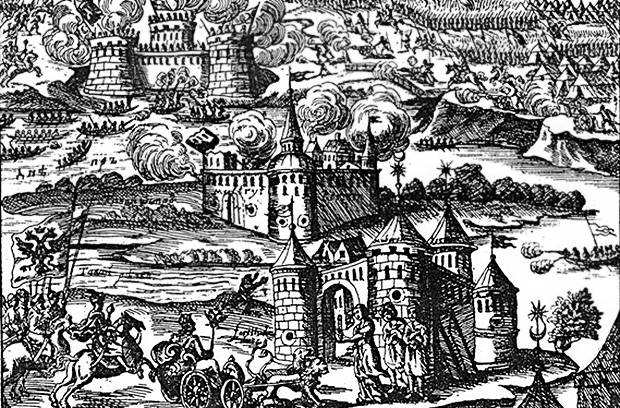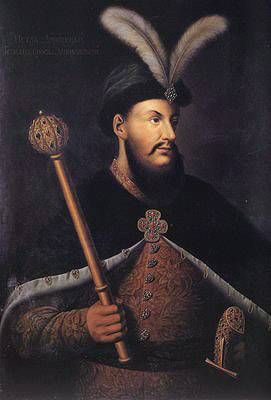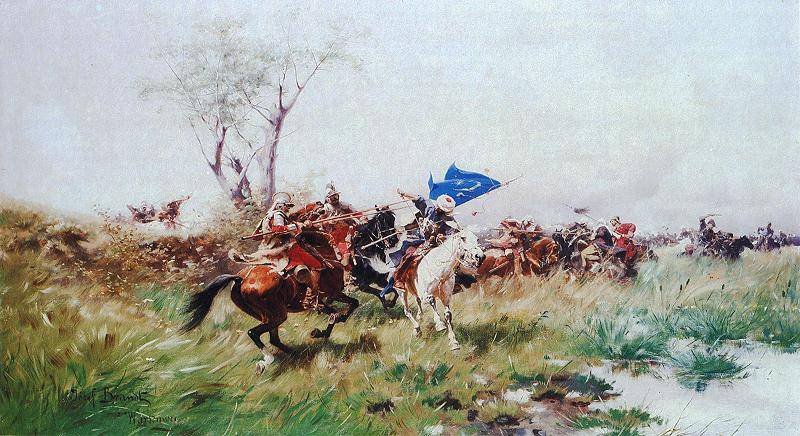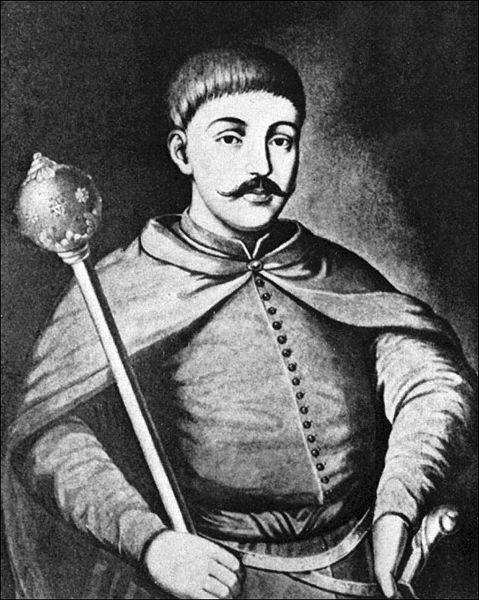How Turkey tried to invade Ukraine

The capture of the tsarist and Cossack regiments of the Turkish and Tatar fortresses. Engraving by L. Tarasevich
340 years ago, Russia, Turkey and the Crimean Khanate concluded the Bakhchisarai Peace.
The Russian state repulsed the onslaught of the Ottoman Empire to the north. The Turks recognized the power of Moscow in the Left-Bank Ukraine. Kiev remained with Russia. However, Porta temporarily took Podillya from the Poles and established itself in the Right-Bank Ukraine, which turned into a desert.
War for Ukraine
During the national liberation war led by Bohdan Khmelnytsky and the Russian-Polish war of 1654-1667. The Russian kingdom was able to return the lands that were lost during the Troubles, including the Novgorod-Seversk land (with Chernigov and Starodub) and Smolensk.
The Polish-Lithuanian Commonwealth recognized Russia as the right to the Left-Bank Ukraine. Kiev temporarily retreated to Moscow. But he was kept by the Russian state. That is, Moscow was able to return part of the lands of the Old Russian state, to reunite parts of the single Russian people.
However, they have not yet been able to fully solve the problem of uniting all Russian lands.
During a series of bloody uprisings, revolts of the gentry, wars with Russia and Sweden, the Commonwealth experienced a severe crisis and was in decline. The Polish elite could not use this period to reform the system of government and liquidate the "gentry democracy", which led the state to disaster.
Turkey decided to take advantage of the weakening of Poland. In Istanbul, they planned a wide expansion to the north. The time was favorable. Austria was recovering for a long time after the terrible Thirty Years' War.
The Turks landed in Crete and after a long struggle with the Venetians captured the strategic island. Austria tried to intervene, but in 1664 it was forced to conclude an unprofitable peace with Porte.
In Ukraine (in Little Russia-Russia), the struggle for power continued.
In 1665, Petro Doroshenko (1627-1697) became the hetman of Right-Bank Ukraine. As a registered Cossack, Doroshenko was promoted to the ranks of the Cossack foreman during the Khmelnytsky war against the Commonwealth. During the reign of hetmans Bogdan Khmelnitsky and Ivan Vyhovsky, he was a prilutsk and later a Cherkasy colonel. Under Hetman Pavel Teter, since 1663, he became the general chieftain in the right-bank army. After defeat and flight, Teteri became hetman.
Doroshenko relied on the Cossack foreman (the Ukrainian "nobleman", which took over the worst qualities of the Polish population) and the clergy, led by Metropolitan Joseph of Kiev, who were guided by Turkey and the Crimean Khanate. Doroshenko's supporters believed that the Port was relatively far away, the Crimean Khanate was weak. Therefore, with their help, you can fight off Poland and Russia and achieve a relatively high autonomy under the auspices of the Ottomans and Crimeans.

Hetman of Right-Bank Ukraine Pyotr Dorofeevich Doroshenko (1627-1697). Portrait of the early XNUMXth century
Polish-Cossack-Tatar war
Doroshenko ordered the expulsion of the Poles from the Right-Bank Ukraine.
And at the same time he attacked the Left Bank. But he did not succeed. The Right Bank Hetmanate was too weak to unite all the Western Russian lands, to throw back Warsaw and Moscow.
In 1666, Doroshenko recognized himself as a vassal of the Port, and the Crimean horde under the command of Devlet-Girey came to his aid. In December 1666, Cossack-Tatar troops defeated a Polish detachment under the command of Makhovsky near Brailov.
In 1667, the Polish-Lithuanian Commonwealth concluded the Andrusov armistice with Russia, but its forces and resources were depleted by a long war and rebellions of the gentry. Warsaw was unable to provide significant assistance to the population of Podillya and Lublin region.
The resistance was headed by the full crown hetman (deputy commander-in-chief) Jan Sobieski. Soon he became the great crown hetman (commander in chief).
Sobieski mobilized everyone he could, including the peasant militias (Russian-Rusyns), for whom the Tatar invasion was worse than the lord's power. The garrisons of the fortresses were reinforced. Cossacks and Tatars did not succeed and turned to Lvov. Sobieski blocked their way.
In a ten-day battle at Pidhaitsy (October 1667), 9 thousand Sobieski's detachment (most of the peasants) repulsed the attack of 30-35 thousand Cossack-Tatar army of Kyrym-Girey and Doroshenko.
Sobieski took a comfortable position, reinforced by field installations. Cossacks and Tatars could not interact and use their numerical advantage. Therefore, the Polish infantry and artillery repelled enemy attacks, and the cavalry successfully counterattacked.
Kyrym-Girei and Doroshenko tried to organize a siege of the Polish fortified area, but at this time the Polish troops intensified in the rear of the Cossack-Tatar army. And the Cossacks broke into the Crimea and ruined it so that they remained there
This demoralized the Tatars. They quickly became discouraged when they could not immediately succeed.
Kyrym-Girey concluded a treatise with Sobieski on
The Cossacks had to follow the Tatars.

Cavalry attack. Artist Jozef Brandt
Hadyach treason
Western Russia at that time was divided into four parts: the Zaporozhye Sich, the Left Bank controlled by Russia, and the Right Bank Ukraine. And on an insignificant part of the Right Bank, hetman Mikhail Khanenko, who was subordinate to the Poles, held power.
Zaporozhye occupied an independent position and did not support any of the hetmans. The koshevoy atman was chosen in it for a year. This post was occupied by either Sukhoveenko or Sirko.
The Andrusov armistice led to the partition of Little Russia, and to the emergence of a mass of dissatisfied.
The Cossack foreman did not want to obey Moscow, dreamed of the rights of the Polish gentry. Now it seemed to the Ukrainian elite that it was better to formally submit to a weakened Poland or Turkey, which was overseas, than to Moscow, where there is rigid centralization, order and hierarchy.
The hetman of the Left Bank Ukraine Ivan Bryukhovetsky (1663-1668) was offended by Moscow, as he hoped to establish his power on the Right Bank with Russian help.
The Polish lords were outraged by the loss of most of the Ukraine. They did not abandon their attempts to embroil Moscow with the Cossacks. In the lands that they were able to return, the gentry began to restore the usual order with the help of massive vice, gallows. There they were fighting three skins from the peasants. The common people howled.
This was used by Doroshenko, who announced that
Doroshenko came up with a plan on how to take the Left Bank from Russia with the help of Bryukhovetsky.
The narrow-minded and stupid left-bank hetman was deceived like a child. He was persuaded to leave Moscow, promising to make him hetman
under the auspices of Turkey and the Crimean Khanate.
At the same time, Doroshenko promised that he would give up his hetmanate.
The second Metropolitan of Kiev Methodius, offended by Moscow, also betrayed him, dreaming of being independent from the Moscow Patriarchate.
Methodius began to help Doroshenko. He announced that he was allowing the Cossacks and Bryukhovetsky to take the oath to the tsar.
The left-bank hetman took the bait, gathered his secret parliament in Gadyach. They decided to expel the tsarist governors and officials, sent delegations to Bakhchisarai and Constantinople to ask for patronage.
Provocations began.
In Crimea, the assassination of the tsar's ambassador Lodyzhensky was organized. The local West Russian population was turned against the tsarist tax collectors. Like, now instead of Poles we are being enslaved by "katsapi".
On the unspoken order of the hetman, Ukrainian cities refused to pay taxes, the hetman's and colonel's henchmen beat the collectors, bullying the tsarist warriors.
Disturbing news poured into Moscow. Tsar Alexei Mikhailovich decided to visit Kiev in order to visit holy places and show the people the unity of the Russian state, to listen to the complaints of the local population. This spurred the conspirators, their designs were threatened.
There were rumors that the tsar would lead an army and deprive Ukraine of the remaining "liberties". The uprising was scheduled for the end of winter, so that the spring thaw would give a gain in time.
On February 8, 1668, the hetman summoned the tsarist governor Ogaryov to his residence in Gadyach and demanded to get out. He promised free passage, otherwise death to all "aliens".
Ogarev had only 280 warriors, and he left the city. In the field, supporters of Bryukhovetsky attacked a small detachment. In an unequal battle, half of the soldiers fell, the governor and the other part were captured.
After that, riots broke out in other cities. The Tsar's governors were captured, the warriors were killed.
So, in Starodub Ignatius Volkonsky died with the entire garrison. In Novgorod-Seversky, Kvashnin's detachment fell in an unequal battle.
In total, 48 cities and towns were deposited from the Russian state.
The death of Bryukhovetsky
Bryukhovetsky tried to negotiate with the Sultan and swore allegiance to him.
The hetman tried to raise the Don, sent an appeal to the local Cossacks:
Here the lie did not pass. Donets tied envoys and gave them to Moscow.
And in Ukraine, the uprising did not work out for the whole people.
Many simple Cossacks were simply confused, confused by the rapid and overwhelming events. They simply did not have leaders to oppose the outrageous hetman and colonel troops.
In Kiev, the townspeople took the side of Russia, and the governor Sheremetev held the city. Nizhyn and Pereyaslavl with strong garrisons also held out. They did not fall for the bait "to leave freely". In Chernigov, voivode Tolstoy also held the old city and beat many of the besiegers.
The Russian government ordered the governor Grigory Romodanovsky in Belgorod to lead an army to the Ukraine. During the war with Poland, he commanded our troops in the south. But the traitors' calculations for the spring thaw were fully justified.
The spring of 1668 was late, in April there was still snow, then the roads became limp. Angry letters came from Moscow. In May, despite the bad roads, the governor had to set out. The carts and guns were immediately stuck tightly. The warriors were exhausted.
In this situation, Romodanovsky decided not to go deep into the rebellious territory and stopped at the border. He surrounded Kotelva and Oposhnya, sent on light cavalry detachments. The cavalry of Prince Shcherbatov and Likharev defeated the enemy at Pochep and near Novgorod-Seversky.
Romodanovsky lured the enemy away and his plan worked.
Bryukhovetsky decided to speak. Shelves from the Right Bank were pulled up to him, which allegedly fell away from Doroshenko. The ambassador of Turkey and Crimea arrived and took the oath of allegiance to the Sultan. Tatar troops also came, but they immediately demanded money, otherwise the Crimeans did not want to fight. Doroshenko also arrived.
In June 1668, Doroshenko and Bryukhovetsky met on the Serb field near Dikanka. Here the deception was revealed that Doroshenko was not going to give up the hetman mace in favor of Bryukhovetsky. On the contrary, Doroshenko demanded that Bryukhovetsky surrender the signs of hetman power. He asked for help from Murza Chelibey, who dismissed it. They say that the internal disassembly of the Sultan's Cossacks does not concern. By order of Doroshenko, Bryukhovetsky was beaten to death.
However, this dastardly murder angered ordinary Cossacks.
The army seethed, shouted that Doroshenko was infidel and sold out to the Tatars. The hetman and the foreman had to persuade and water the Cossacks for a week in order to recognize Doroshenko as hetman of both parts of Ukraine. But the unrest continued.
The Crimeans, having received gold ahead, returned home. The Cossacks left, who nominated their candidate for the place of hetman - clerk Sukhovienko. And the Left Bank Cossacks, not wanting to serve as the henchman of the Sultan, were unreliable. As a result, Doroshenko thought about it and returned to Chigirin.

Ivan Martynovich Bryukhovetsky (1623-1668). In the portrait of the XNUMXth-XNUMXth centuries.
Hetman the Sinful
Before leaving, Doroshenko appointed Chernigov Colonel Demyan Mnogogreshny as a hetman in the Left Bank Ukraine.
He had to confront the tsarist army. Meanwhile, Romodanovsky still did not go deep into the territory of Ukraine. Obviously, he did not want to use the strategy of the Poles - to burn village after village, city after city, drown the uprising in blood, embittering the people. He only provided assistance to the surviving garrisons.
In September, Doroshenko's supporters were still able to deploy an army and moved to the Severshchina. Romodanovsky waited for the moment when he could defeat the enemy with one blow.
Some of the rebels were approaching Nizhyn. They threatened the governor of Rzhevsky. And then they learned that the Russian army was already nearby. The rebels scattered.
The sinful man led his army to Chernigov, where Tolstoy's garrison was still defended. The Cossacks went to storm. The royal warriors, under the onslaught of superior forces, retreated to the city castle. But at this time Romodanovsky approached Chernigov. His appearance was so unexpected that the tsarist troops blocked the rebels.
The Cossacks did not want to die. Immediately there were supporters of Moscow, they persuaded the hetman to start negotiations. The sinful man promised to leave Chernigov if released. The tsarist commander proposed reconciliation. In the end, we agreed.
The Cossacks left the city and sent a delegation
The hetman took the oath to the tsar and sent an embassy to Moscow.
As soon as a second center of power emerged in Ukraine, which wanted peace with Moscow, the uprising began to fade.
The colonels deferred from Doroshenko, negotiated forgiveness. The Cossacks announced that Doroshenko -
and also entered into negotiations with Romodanovsky.
Metropolitan of Kiev Joseph Tukalsky asked Moscow on what conditions he could keep his post.
In December 1668, the mandated hetman Mysogreshny was elected hetman of the entire Left-Bank Ukraine at the Cossack council in Novgorod-Seversky. And on behalf of the entire foreman, he took the oath to Emperor Alexei Mikhailovich.
In March 1669, the Rada in Glukhov again elected him hetman. The new hetman concluded the Glukhov articles with Tsar Alexei Mikhailovich.
According to them, the tsarist garrisons could only stand in five Western Russian cities - Kiev, Pereyaslav, Chernigov, Nizhyn and Ostra. The register of Cossacks increased to 30 thousand.
Only a Cossack foreman could collect taxes in Little Russia and Zaporozhye. The Hetman could not have diplomatic ties with other powers.
But at the same time, a new threat arose.
The Ottoman army completed the capture of Crete, defeated the Arab rebels and returned Basra. Istanbul is aiming north.
The Sultan made an official statement that he was taking Doroshenko into citizenship from all over Ukraine.
To be continued ...
Information